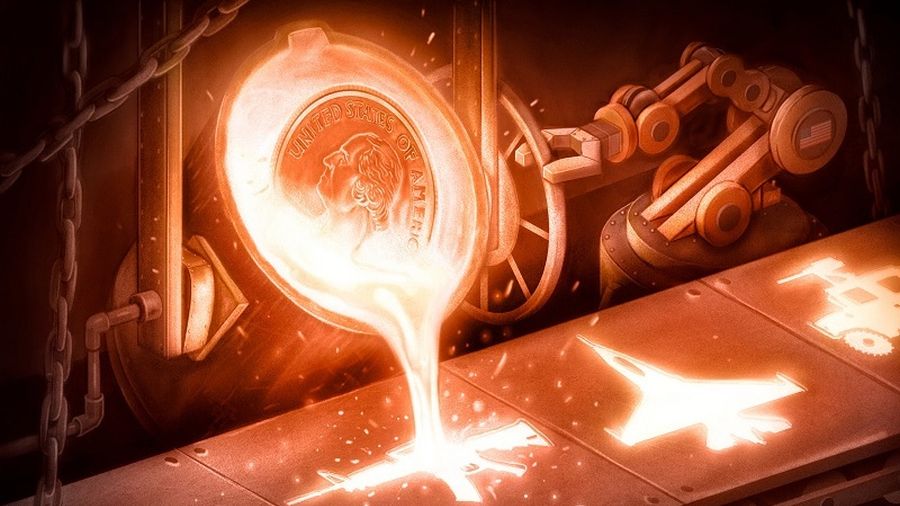The Ukrainian Proxy War Exposes The West’s Military-Industrial Limitations
It’s a matter of military fact that the Ukrainian proxy war, which saw more third-party military-technical assistance dispatched in a larger amount and in a shorter time to one of the direct participants than in any previous conflict in history (remembering that the Lend-Lease Act didn’t scale up till after some time), has already depleted plenty of Western reserves but hasn’t stopped their Russian opponent.
Bloomberg published an intriguing piece last week titled “Ukraine War Is Depleting America’s Arsenal Of Democracy”. The gist is that the US-led West’s emergency transfer of military-technical equipment to Kiev has drastically depleted their own such reserves. That in turn raises questions not only about their present defense preparedness capabilities in these newfound circumstances, but also whether they can continue to sustain this policy towards that proxy war and if they’re even able to do so with respect to any other forthcoming ones that might soon be sparked elsewhere in the world too.
According to author Hal Brands, the US no longer has the manufacturing base that it relied upon to unprecedentedly scale up production during World War II and ultimately win that global conflict. In his assessment, “It may take months or years to significantly ramp up production” to replace just the one-third of its Javelin stockpiles that it’s already sent to Ukraine, not to mention its other military-technical equipment that it dispatched there as well. This has created a dilemma that’ll be difficult to resolve, though Brands has two proposals for what the US should do.
He suggests that “Greater investments in the defense industrial base and more aggressive purchasing and stockpiling of key munitions can help. The creation of a reserve industrial corps (civilians who have basic peacetime training so they can contribute to wartime production) is worth exploring.” Furthermore, he writes, “Key allies, such as Japan, may be able to help the U.S. surge production in shipbuilding and other areas.” All of that takes time to implement, though, so it’s unclear whether the present policy of providing billions of dollars of military-technical equipment to Kiev can be sustained.
His article is important to reflect upon precisely because it’s a mostly objective piece about one of the “politically incorrect” aspects of this proxy war, namely the military-industrial limitations of Kiev’s US-led Western patrons. The Mainstream Media (MSM) focuses exclusively on Russia’s such limitations, both those that are realistically thought to exist as well as genuinely fake news about its capabilities. These efforts are intended to contribute to the information warfare campaign alleging that Russia’s ongoing special military intervention in Ukraine has been an abysmal failure in all respects.
Not discussed almost whatsoever at all, apart from Kiev’s objectively existing military failures, is its patron’s military-industrial limitations. The reason for that is obvious since it would make the targeted Western audience very uncomfortable to countenance that their civilizational bloc can’t indefinitely sustain a proxy war against Russia, which the MSM presents as an existential threat to their way of life. The truth, as Brands makes clear in his article, is that Western military support for Kiev cannot be sustained indefinitely and that some changes to this policy might soon be afoot out of simple necessity.
That’s not to say that Russia might not be experiencing a similar dilemma, but just that it’s only one country while its opponents in Ukraine are backed up by a coalition of 30 foreign militaries, including the world’s most powerful American one. This observation means that it’s already beyond impressive that Moscow was able to achieve tangible on-the-ground progress in the eastern and southern parts of that former Soviet Republic at all since it shows that not even the West’s emergency shipping of unprecedented amounts of aid to Kiev could completely stop the Russian military machine.
The propaganda being spewed by the MSM about this proxy war might not subside for some time, if at all, but Western policymakers must be soberly assessing the situation back in their respective capitals. It’s a matter of military fact that the Ukrainian proxy war, which saw more third-party military-technical assistance dispatched in a larger amount and in a shorter time to one of the direct participants than in any previous conflict in history (remembering that the Lend-Lease Act didn’t scale up till after some time), has already depleted plenty of Western reserves but hasn’t stopped their Russian opponent.
This observation might lead to a fundamental rethinking about the ways in which the West wages proxy wars against its so-called peer competitors like Russia and China. They can apply Brands’ advice to create a “reserve industrial corps” and agree to a so-called “division of military-industrial labor” across this civilizational bloc, reconsider the wisdom of waging such proxy wars in the first place, or perhaps even decide to directly intervene as a tripwire for dangerously escalating tensions to the point of nuclear brinksmanship in the hopes of coercing unilateral concessions from their proxy opponent.
Whatever they end up doing, which might vary depending on whichever proxy war they might be waging, it’s clear that the precedent established by the Ukrainian proxy war has taught the US-led West some painful lessons about its military-industrial limitations. It’s impossible to indefinitely sustain the assistance that they’re providing to Kiev since their reserves have already largely been depleted in less than two months and without stopping Russia’s operation like they expected would happen by now. Their existing policy has therefore been a failure and must urgently be revised in the face of this fact.







